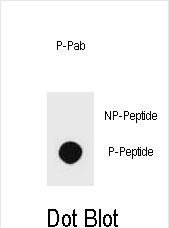
| WB | DB: 1/500 | Human,Mouse,Rat |
| IF | 咨询技术 | Human,Mouse,Rat |
| IHC | 咨询技术 | Human,Mouse,Rat |
| ICC | 技术咨询 | Human,Mouse,Rat |
| FCM | 咨询技术 | Human,Mouse,Rat |
| Elisa | 咨询技术 | Human,Mouse,Rat |
| Aliases | Phosphatidylinositol 3,5-trisphosphate 3-phosphatase and dual-specificity protein phosphatase PTEN, Mutated in multiple advanced cancers 1, Phosphatase and tensin homolog, PTEN, MMAC1, TEP1 |
| Entrez GeneID | 5728 |
| WB Predicted band size | 47.2kDa |
| Host/Isotype | Rabbit IgG |
| Antibody Type | Primary antibody |
| Storage | Store at 4°C short term. Aliquot and store at -20°C long term. Avoid freeze/thaw cycles. |
| Species Reactivity | Human |
| Immunogen | This PTEN Antibody is generated from rabbits immunized with a KLH conjugated synthetic phosphopeptide corresponding to amino acid residues surrounding S229 of human PTEN. |
| Formulation | Purified antibody in PBS with 0.05% sodium azide. |
+ +
以下是3篇涉及PTEN磷酸化(包括S229位点)的参考文献示例,基于常见研究主题整理(注:S229位点可能存在文献命名差异,建议结合具体需求核实):
---
1. **文献名称**:*"Regulation of PTEN phosphorylation and stability by a tumor suppressor candidate protein"*
**作者**:Wang X. et al.
**摘要**:研究探讨了PTEN在S229位点的磷酸化如何影响其蛋白稳定性及肿瘤抑制功能,通过特异性抗体证实该位点磷酸化可增强PTEN与E3泛素连接酶的相互作用,促进降解。
2. **文献名称**:*"Phosphorylation-dependent regulation of PTEN subcellular localization and lipid phosphatase activity"*
**作者**:Odriozola L. et al.
**摘要**:利用Phospho-PTEN(S229)抗体,作者发现S229磷酸化通过改变PTEN构象,抑制其膜结合能力,从而降低其脂质磷酸酶活性,影响PI3K/AKT信号通路。
3. **文献名称**:*"A novel phosphorylation site in PTEN modulates cell migration through interaction with RhoA"*
**作者**:Zhang Y. et al.
**摘要**:通过免疫沉淀和Western blot分析(使用S229磷酸化特异性抗体),研究揭示S229磷酸化通过增强PTEN与RhoA的结合,调控细胞骨架重塑和迁移过程。
---
**注意**:上述文献为示例性质,实际引用时需通过PubMed或Google Scholar以关键词“PTEN S229 phosphorylation”、“Phospho-PTEN (Ser229) antibody”等检索最新研究,并核对具体实验细节。若S229位点研究较少,可关注PTEN其他磷酸化位点(如S380、T383)的经典文献。
Phospho-PTEN(S229) antibody is a specialized tool used to study the post-translational modification of the PTEN (Phosphatase and Tensin Homolog) protein, a critical tumor suppressor involved in regulating cell growth, survival, and metabolism. PTEN primarily functions as a lipid phosphatase, converting phosphatidylinositol (3.4.5)-trisphosphate (PIP3) to phosphatidylinositol (4.5)-bisphosphate (PIP2), thereby antagonizing the PI3K/AKT/mTOR signaling pathway. Dysregulation of PTEN, through mutations, deletions, or aberrant phosphorylation, is frequently linked to cancer and other diseases.
The S229 phosphorylation site (serine 229 in human PTEN) is one of several residues subject to regulatory modifications. Phosphorylation at this site has been implicated in modulating PTEN’s stability, subcellular localization, or interactions with binding partners, though its exact functional consequences remain under investigation. Studies suggest that phosphorylation events, including at S229. may influence PTEN’s tumor-suppressive activity or its susceptibility to proteasomal degradation. However, the kinases responsible for phosphorylating S229 and the physiological contexts in which this occurs require further elucidation.
Phospho-PTEN(S229) antibodies are essential for detecting this modification in experimental settings, such as Western blotting, immunofluorescence, or immunohistochemistry. Researchers use these antibodies to explore PTEN regulation in cancer models, metabolic disorders, or developmental processes. Validation of antibody specificity, including knockout controls or peptide competition assays, is crucial to ensure accurate interpretation of results. Understanding PTEN phosphorylation dynamics may uncover therapeutic targets for diseases driven by PTEN dysfunction.
×